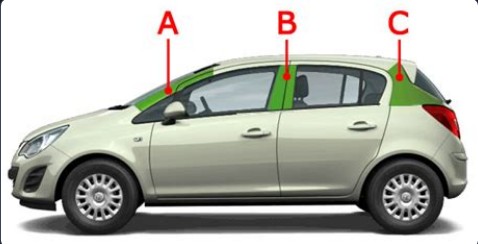- Observation points (use when moving off)
- Observation points when overtaking
- Downhill start - Key Points
- Uphill start - Key Points
- Orientation points
- [[#Orientation points#Pillars|Pillars]]
- [[#Orientation points#Pedals|Pedals]]
- [[#Pedals#order of pedals|order of pedals]]
- [[#Pedals#Vital Info|Vital Info]]
- ABBR
- Stating a car
- Stopping car
- Stopping on the right - Key Points
- Steering
- MSPSL (Mirrors, signal, position, speed, look)
- [[#MSPSL (Mirrors, signal, position, speed, look)#Turning Left|Turning Left]]
POM (Prepare Observe Move):
- Preparing your car to move off (Hand brake on & Gear into Neutral)
- Start the engine
- Into 1st gear
- Set the gas pedal (when needed)
- Find biting point
- Observation and Signaling
- No need to signal if it’s unnecessary (if no other users)
- Habitual, unnecessary signals can cause problems
- Provide signals where they aid other road users
- Ensure signals given are not misleading
- Moving off
- before moving off always check mirrors to the side where you move to
- Stopping safely
- Use Hazard routine - Mirrors, Signal, Manoeuvre routine (MSM)
- Always use your mirrors before stopping or signaling
- Use all mirrors before stopping
- Press the footbrake gently and then press the clutch (just before stopping)
- Look well ahead as you stop
- Parking brake on; Into neutral to secure the car
BBC (Brake Before Clutch) Hazard routine - Mirrors, Signal, Manoeuvre (MSM)
Observation points (use when moving off)
- Left shoulder
- Left door mirror
- Interior mirror
- Road ahead
- Right door mirror
- Right shoulder
Observation points when overtaking
- Interior mirror (check no one is starting to overtake you)
- Right mirror (ensure no one is already overtaking you from the right)
- Right shoulder check (blind spot check to ensure no cars are next to you on the side you intend to move to)
- Indicate right (signal your intention to move right)
- Move to the lane (after ensuring it’s safe to do so)
- Cancel indicator (after successfully changing lanes)
Downhill start - Key Points
- Gravity provides the power needed to move off
- Press the footbrake before releasing the parking brake
- 2nd gear might be best on steeper hills
- Remember your all round observation
- Bring the clutch up as the car starts to move
- You might have to keep braking as you move off
Uphill start - Key Points
- You need more power for uphill starts
- Increase pressure on the gas pedal as the clutch bites
- You might need a bigger gap in the traffic
- You will need to go faster before changing to 2nd gear
gear shifter gear stick gear lever
Orientation points
Pillars
A Front
B Middle
C Back

Pedals
order of pedals
clutch, break, accelerate (CBA)
Vital Info
- dead space / slack - for break pedal as it starts working after a small press only.
- lurch forward /dash forward / sudden stop with a jerk
- engine spins too quickly - 1st gear make it work slower then it transmits its power to wheels
- clutch (all the way down) + break = disconnects/disengages engine and wheels(engine runs, wheels not)
- no pressed clutch - means engine and gear is connected
In a manual transmission car, the engine is mechanically connected to the wheels through the transmission and the clutch.
ABBR
DSSSM (Door, Seat, Sterling wheel, Seat belt, Mirrors) MSPSL (Mirrors, signal, position, speed, look) My Sister Painted Some Lively Lemons
Stating a car
- Clutch
- foot brake
- shift to the 1st gear from neutral
- remove hand brake
- remove leg foot brake (we should not roll)
- check mirrors
- start pressing gas pedal
Stopping car
- your foot is over/on the gas pedal
- check mirrors, indicate (left right)
- release gas
- gradually start stopping
- use clutch when you feel it rumbles
- after car is stopped - use hand brake
- off the foot brake
- off the clutch
Stopping on the right - Key Points
- After your test you will sometimes need to park on the right
- You might be asked to stop on the right during your test
- Signal early to alert/warn other road users
- Give way to approaching traffic
- Start your POM routine with your right shoulder
- Move back to the left as soon as possible
Steering
- you one hand should always be on the wheel
- u must not cross your hands when steering
MSPSL (Mirrors, signal, position, speed, look)
My Sister Painted Some Lively Lemons
use MSPSL before approaching any junctions.
- Mirrors(interior and the mirror to the side where you are turning)
- Signal if it would benefit anyone
- Position (left or right)
- Speed (Slow down)
- Look / Decide
Turning Left
Before turning give way to pedestrians
Mirrors - Key Points:
- Check your mirrors first to make sure that it’s safe to turn
- You can use all your mirrors
- Interior and left door mirrors are usually the most useful
- Always check your mirrors before signalling
- You will need your mirrors more than once
Signal - Key Points:
- Always check your mirrors before signalling
- There is no fixed distance from which you should give a signal
- Junction location, speed and speed limits affect signal timing
- Signal sooner on fast roads and for very tight turns
- Take care not to give misleading signals
Always check mirrors again after a turn to make sure you can speed up (and noone is trying to overtake you)
Position:
- Keep your normal road position
- Moving left risks tyre damage or hitting the kerb
- Moving right creates a hazard for approaching traffic